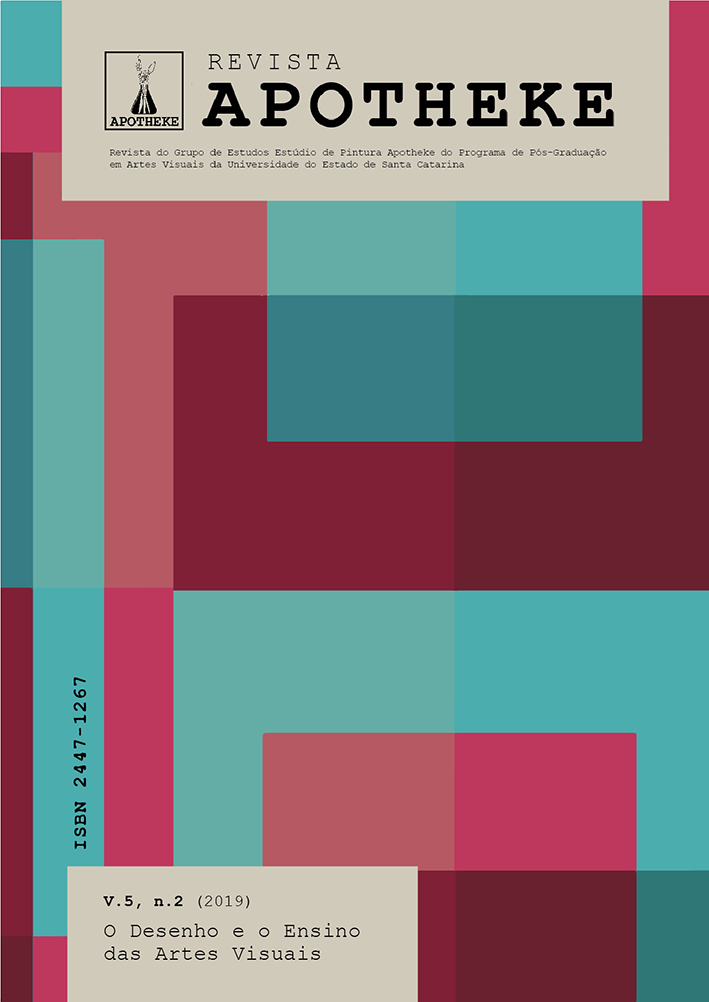Uma reflexão autoenográfica sobre a aprendizagem e o ensino do desenho
DOI:
https://doi.org/10.5965/24471267522019010Keywords:
drawing , human figure , auto-ethnography , learning , teachingAbstract
This text addresses the theme of learning and teaching drawing from a personal experience. It aims to share knowledge about a specific context, which can be compared with other cases in this field of study. Based on the Auto-Ethnographic perspective of David M. Hayano (1979), it constructs a chronological biographical narrative.It presents a descriptive synthesis of everyday events related to the problem of the development of technical skills of figurative drawing. It describes some of the difficulties encountered during drawing teaching activities in undergraduate courses in the field of visual arts. It lists some of the strategies used to overcome them, and ends with a reflection on the role of repetitions and corrections in the acquisition of these competences.
Downloads
References
BAMMES, Gottfried. The Complete Guide to Anatomy for Artists & Illustrators: Drawing the Human Form. England: Kent: Watson-Guptill, 2017.
CALDERÓN, Alfonso. Dibujando la figura humana. 5 ed. Barcelona: CEAC, 1981.
DÉLAVIER, Frédéric. Guia dos movimentos de musculação para mulheres: Abordagem anatômica. São Paulo: Manole, 2003.
DÉLAVIER, Frédéric. Guia dos movimentos de musculação: Abordagem anatômica. São Paulo: Manole, 2000.
GALVÃO, Alfredo. Noções de Anátomo-Fisiologia Artística e de Proporções: proporções da figura humana e do cavalo. Rio de Janeiro: Globo: 1942.
HAYANO, David M. Auto-Ethnography: paradigms, problems, and prospects. In: Human Organization. New York: Society for Applied Anthropology. 1979, Vol. 38, n. 1, p. 99-104. Disponível em: https://www.jstor.org/stable/44125560. Acesso em: 26 jun. 2019.
PARRAMÓN, José Maria. Cómo dibujar la figura humana. Barcelona: Parramón, 1986.
RICHER, Paul. Artistic Anatomy. Reprint. New York: Watson-Guptill, 1986.
WINSLOW, Valerie L. Classic Human Anatomy in Motion: The Artist's Guide to the Dynamics of Figure Drawing. Reprint. New York: Watson-Guptill, 2015.
WINSLOW, Valerie L. Classic Human Anatomy: The Artist's Guide to Form, Function, and Movement. Reprint. New York: Watson-Guptill, 2008.
Downloads
Published
How to Cite
Issue
Section
License
Copyright (c) 2019 REVISTA APOTHEKE

This work is licensed under a Creative Commons Attribution-NonCommercial 4.0 International License.
Copyright and Licensing Policy
Authors of works submitted to Revista APOTHEKE authorize their publication in both print and digital formats exclusively for academic purposes. Reproduction is permitted, provided that the source is properly cited. Authors confirm the originality, authorship, and unpublished status of their manuscripts.
Articles published by the journal are freely available and intended for academic and non-commercial use only. All copyrights are transferred to the journal. The content of signed articles reflects the views of their respective authors and not the official position of Revista Apotheke. The author(s) agree to always cite the following reference when republishing or referring to the content originally published in Revista Apotheke:
“This article was originally published by Revista Apotheke in volume (insert volume), number (insert number), year (insert year), and is available at: http://www.revistas.udesc.br/index.php/APOTHEKE/index”
It is the sole responsibility of the authors to obtain written permission for the use of any material protected by copyright law included in their articles. Revista Apotheke is not responsible for copyright infringements committed by contributors.
Authors retain copyright and grant the journal the right of first publication, with the work licensed under a Creative Commons Attribution-NonCommercial License (CC BY-NC):
-
Attribution (BY): Licensees are allowed to copy, distribute, display, perform, and create derivative works, provided that proper credit is given to the author or licensor, in the manner specified.
-
NonCommercial (NC): Licensees may use the material only for non-commercial purposes.
After publication, authors retain the rights to their work and may republish the text.



